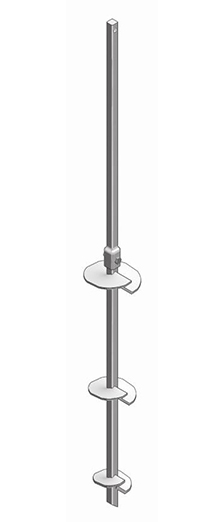CHANCE® Helical Anchors
 Since the early 1960s, CHANCE® Helical Anchors have been used in the electric transmission industry as the primary guy anchor solution. Today, these screw anchor foundations are finding increased popularity in civil construction applications because of the versatility and cost-effectiveness of this uplift (tension) restraint solution. CHANCE® helical ground anchors extend bearing plates through soft, loose, or expansive surface soils into stable strata with minimal disturbance. Discover how helical earth screw anchor systems are the predictable, cost-effective, quickly installed alternative to traditional uplift restraint methods.
Since the early 1960s, CHANCE® Helical Anchors have been used in the electric transmission industry as the primary guy anchor solution. Today, these screw anchor foundations are finding increased popularity in civil construction applications because of the versatility and cost-effectiveness of this uplift (tension) restraint solution. CHANCE® helical ground anchors extend bearing plates through soft, loose, or expansive surface soils into stable strata with minimal disturbance. Discover how helical earth screw anchor systems are the predictable, cost-effective, quickly installed alternative to traditional uplift restraint methods.
What Are Helical Anchors Used For?
Helical anchors are commonly selected for earth anchoring applications because they are quick to install and can be proof-tested and loaded immediately with no concrete to cure or de-watering of the excavation to deal with. Helical earth screw anchors are often chosen over traditional anchoring methods such as concrete deadmen or grouted anchors in order to overcome limited accessibility or the presence of a high water table.
How to Install Helical Anchors
A helical ground anchor is used to resist tensile loading. For these tension-only soil anchors, square shaft helical anchors are the logical choice. The helical anchor is segmented with helical bearing plates welded to a central steel square shaft. Load is transferred through the shaft to the soil through the bearing plates. CHANCE screw anchors are coupled together with couplings, and the only limit to installation depth for these earth anchors is soil density. Engineers can achieve whatever depth makes sense economically.
Since the plates are helical, they do not auger, but rather screw into the soil with minimal disturbance. Helical bearing plates have a standard 3" pitch and are spaced at far enough distances from enough apart that they bear load independently of each other; therefore, the load capacity of one is not influenced by adjacent plates.
Working on a design project using helical piles and anchors? HeliCAP™ is a free civil engineering software platform that helps calculate capacity requirements for CHANCE® helical products. Control for soil parameters, environmental variables, and other essential criteria to select the appropriate pile/anchor size needed for your individual project requirements.
Helical Anchor Applications
- Anti-Buoyancy
- Communication Tower Foundations
- Guy Anchoring
- Pipeline Foundations
- Swimming Pool Foundations
CHANCE Helical Ground Anchor Case Studies
Request a Quote
Have questions about any of our foundation CHANCE Helical Ground Anchor products? Ready to get started on your next project? Looking for expert advice? Request a quote now to speak with our professional team of experts about specifications, pricing, and any additional questions you may have. We’ll get back to you within one business day.
